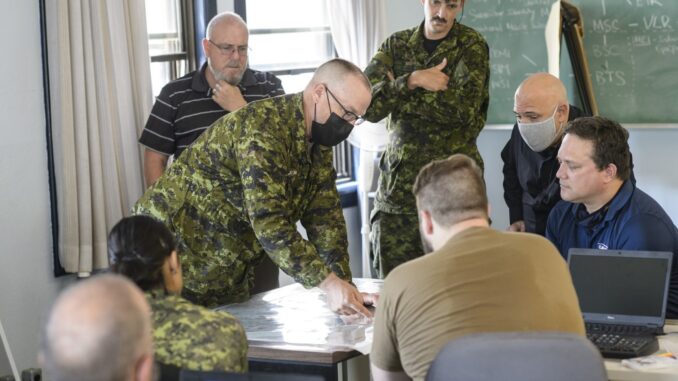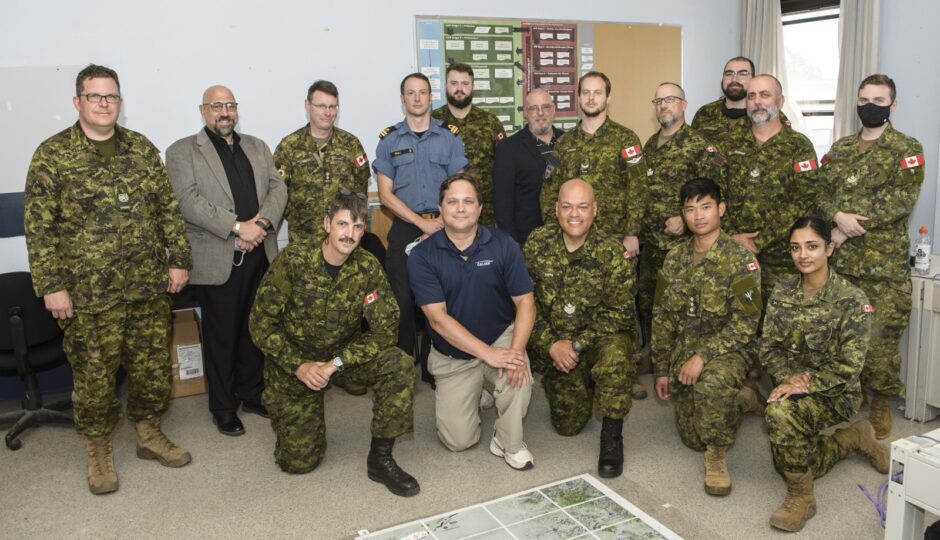
On 18-21 July 2022 at CFB Kingston an Opposing Force (OPFOR) Threat Tactics Course (TTC) was delivered by a US Army Training Doctrine and Command (TRADOC) mobile training team (MTT). The OPFOR TTC provides information and guidance on how to implement the doctrinal OPFOR structures, tactics, and mindset to meet training requirements within an exercise environment.
A total of fifteen officers, non-commissioned members and civilians from multiple disciplines participated in this forty-hour course. Participants discussed and applied threat tactic theories to a series of table top exercises that encouraged them to “think like the adversary”. Students were challenged with difficult scenarios that became more manageable when processed through the lens of the OPFOR. Tasks included shaping the information space, disrupting blue force advances, employing irregular forces and developing plans to block a division sized element when severely overmatched.
The OPFOR TTC helps students understand and apply a hybrid OPFOR threat, based on best practices, with a range of capabilities that is analogous to actual worldwide adversaries. It challenges students to view warfare from the lens of the adversary. When the CAF and its allies conduct operations, the rule of law, the Laws of Armed Conflict and other constraints and restraints are factored into the planning considerations. Our adversaries, whether a nation-state or a stateless organization do not plan or operate with the same constraints. Therefore, when threat tactics are effectively applied in the training environment, Canadian decision makers are exposed to a more robust and realistic hybrid threat.
Commander Ryan Passey, Chief Training at the Canadian Army Simulation Centre (CASC) said of the course, “The Canadian Army Doctrine and Training Centre (CADTC) and TRADOC have a long standing relationship of collaboration. It is excellent when opportunities at the tactical level emerge from these relationships; the Threat Tactics Course held in Kingston 18-21 July was a prime example of this. This course better informed how we represent contemporary adversaries in our training and exposed us to different approaches to enrich the training environment with greater realism. The soldiers and officers who took the course now have new and improved tools in their toolbox when they return to their respective units and work in exercise and courseware design, development, and delivery. I thank TRADOC for facilitating this unique training opportunity and look forward to integrating the learnings in future training activities”.
The knowledge gained by participants in this course will be used to improve the CAF’s understanding of adversarial methods of conducting warfare not only in the land, sea and air but also how they operate in the information space. This course works toward developing a more realistic adversary for the CAF to train against in simulated environments thereby better preparing us for when we are called to duty in real life.
For more information on the OPFOR TTC contact CADTC G5 – Command Support Integration – SENSE Intelligence, Maj Katherine Krenn, katherine.krenn@forces.gc.ca

Back Row From left: MWO Mike Giroux, Kris Lechowicz, LCol Andrew Duncan, Lt(N) Nicolas Hull, Capt Oscar Morgado, Jay Hunt, , Cpl Mael Turbide, Sgt Trevor Saina, Cpl Iain MacSween, MCpl Michael Webber, MCpl Francis Hamel-Giroux
Front Row From Left: MS Brad Congram, Civ Jeff Olaz, Sgt Phillip Safire, Capt Ljogreti Soto, 2Lt Paarkhi Katoch
(Photo: Steve McQuaid CFB Kingston Base Photo)
Author: MS Brad Congram CD, HMCS Cataraqui, / Canadian Army Simulation Centre.
(W): 613-541-5010 x 4387
Brad.Congram@forces.gc.ca
